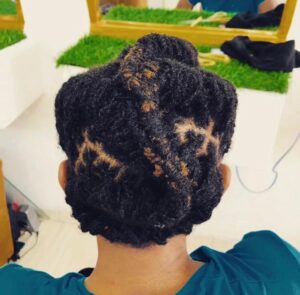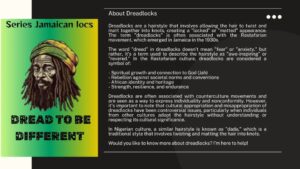How to Maintain Jamaican Locs: A Comprehensive Guide
Jamaican locs, also known as dreadlocks, are a beautiful and culturally significant hairstyle that requires proper care and maintenance to keep them healthy and looking their best. Whether you are new to locs or have been wearing them for years, understanding how to maintain them is essential for their longevity and appearance. Here’s a comprehensive guide on how to care for your Jamaican locs.
1. Cleansing Your Locs
Maintaining clean locs is crucial for scalp health and the overall appearance of your hair. However, it’s important to choose the right products to avoid buildup. Here are some tips for cleansing:
– Frequency: Wash your locs every 1-2 weeks, depending on your lifestyle and scalp condition. If you sweat a lot or use heavy products, you may need to wash more frequently.
– Shampoo: Use a residue-free shampoo specifically designed for locs. These shampoos help prevent buildup and keep your scalp clean. Avoid products with sulfates and heavy oils.
– Technique: When washing, focus on your scalp. Gently massage the shampoo into your scalp and let the suds cleanse the locs as they rinse out. Avoid rubbing the locs too vigorously to prevent frizz and unraveling.
2. Moisturizing Your Locs
Keeping your locs moisturized is essential to prevent dryness and breakage. Here are some effective moisturizing techniques:
– Water: Water is the best moisturizer for locs. Spritz your locs with water daily or every few days to keep them hydrated.
– Leave-in Conditioner: Use a lightweight leave-in conditioner or a natural oil (like jojoba or coconut oil) to lock in moisture. Apply sparingly to avoid buildup.
– Scalp Care: Don’t forget your scalp! Use a light oil to massage your scalp regularly, promoting healthy hair growth and preventing dryness.
3. Retwisting and Maintenance
Retwisting is an essential part of maintaining locs, as it helps to keep them neat and tidy. Here’s how to do it effectively:
– Frequency: Depending on your hair growth and personal preference, retwist your locs every 4-8 weeks. Over-retwisting can lead to tension and breakage, so find a balance that works for you.
– Products: Use a light gel or natural product designed for locs to help hold the twist. Avoid heavy products that can cause buildup.
– Technique: When retwisting, work in small sections and twist in the same direction. This helps maintain the integrity of the locs and prevents them from unraveling.
4. Protecting Your Locs
Protecting your locs from environmental factors is crucial for their health. Here are some tips:
– Covering: Use a satin or silk scarf or bonnet at night to reduce friction and prevent frizz. This also helps retain moisture.
– Sun Protection: If you spend a lot of time outdoors, consider wearing a hat or using a UV protectant spray to shield your locs from sun damage.
– Avoiding Heat: Limit the use of heat styling tools, as excessive heat can dry out and damage your locs.
5. Dealing with Buildup and Frizz
Buildup and frizz are common concerns for those with locs. Here’s how to manage them:
– Clarifying: Use a clarifying shampoo occasionally to remove buildup. Be sure to follow up with a deep conditioner to restore moisture.
– Frizz Control: To minimize frizz, avoid touching your locs too much and use a light oil to smooth down any flyaways.
6. Regular Trimming
While locs are meant to grow long, regular trimming of the ends can help maintain their shape and prevent split ends. Consult with a professional loctician for the best results.
Conclusion
Maintaining Jamaican locs requires dedication and care, but the rewards are well worth the effort. By following these tips on cleansing, moisturizing, retwisting, protecting, and managing buildup, you can ensure that your locs remain healthy, vibrant, and beautiful. Embrace the journey of your locs, and enjoy the unique beauty they bring to your life!
Exploring Jamaican Locs Styles: A Cultural and Creative Expression
Jamaican locs, often referred to as dreadlocks, are more than just a hairstyle; they are a profound cultural symbol deeply rooted in the history and identity of the Jamaican people. This unique hairstyle has evolved over the years, showcasing a variety of styles that reflect personal expression, cultural heritage, and artistic creativity. In this article, we will explore the different styles of Jamaican locs, their significance, and how they continue to inspire individuals both in Jamaica and around the world.
The Origins of Locs
The history of locs can be traced back to ancient civilizations, but in Jamaica, they gained prominence during the Rastafarian movement in the 1930s. Rastafarians embraced locs as a symbol of their spiritual beliefs and resistance against oppression. The hairstyle represents a connection to African heritage, natural living, and a rejection of Western beauty standards. Over time, locs have transcended their spiritual roots and have become a popular hairstyle among people of various backgrounds.
Types of Jamaican Locs Styles
1. Traditional Locs: Traditional locs are formed by twisting or braiding sections of hair and allowing them to mat over time. This style can vary in thickness and length, depending on personal preference. Traditional locs are often worn long and can be styled in various ways, including updos, ponytails, or left to flow freely.
2. Sisterlocks: Sisterlocks are a popular variation of locs that are smaller and more uniform in size. This style is created using a specific locking technique that involves a special tool to interlock the hair. Sisterlocks are versatile and can be styled in numerous ways, making them a favorite among those who prefer a more refined look.
3. Freeform Locs: Freeform locs are characterized by their natural and organic appearance. This style allows the hair to lock naturally without manipulation, resulting in a unique and individual look. Freeform locs can vary greatly in size and shape, reflecting the wearer’s personality and lifestyle.
4. Interlocked Locs: Interlocked locs are created by pulling the ends of the hair through the base of the loc, which helps to secure the hair and promote growth. This method can create a neat and tidy appearance, making it a popular choice for those who prefer a more polished look.
5. Colored Locs: Adding color to locs is a popular trend that allows individuals to express their creativity. From vibrant hues to subtle highlights, colored locs can enhance the overall look and make a bold statement. However, it’s essential to use hair-safe dyes and techniques to maintain the health of the locs.
6. Locs with Accessories: Many individuals choose to adorn their locs with accessories such as beads, cuffs, and wraps. These embellishments can add a personal touch and reflect the wearer’s style. Accessories can be changed frequently, allowing for endless customization.
Maintenance and Care
Maintaining locs requires a commitment to proper care to ensure they remain healthy and vibrant. Regular washing, moisturizing, and retwisting or interlocking are essential components of loc maintenance. Many individuals also opt for professional services to help maintain their locs, especially for intricate styles like Sisterlocks.
Cultural Significance
Jamaican locs are not just a fashion statement; they carry deep cultural significance. They represent a connection to African ancestry, spirituality, and a sense of community. For many, wearing locs is a way to honor their heritage and express their identity. The hairstyle has also become a symbol of resistance against societal norms and a celebration of natural beauty.
Conclusion
Jamaican locs styles are a beautiful blend of culture, creativity, and personal expression. From traditional locs to modern variations like Sisterlocks, each style tells a story and reflects the individuality of the wearer. As locs continue to gain popularity worldwide, they serve as a reminder of the rich cultural heritage they represent and the freedom of self-expression they embody. Whether worn for spiritual reasons, aesthetic appeal, or personal identity, Jamaican locs remain a powerful symbol of resilience and beauty.






